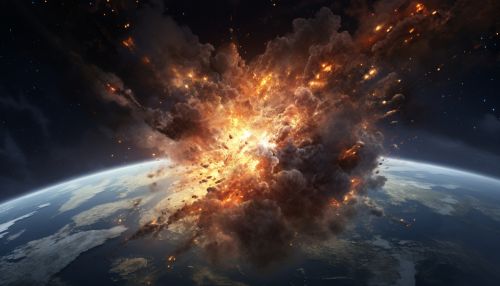Chicxulub impactor
Introduction
The Chicxulub impactor is the celestial body that is believed to have collided with Earth approximately 66 million years ago, causing a massive impact event known as the Chicxulub impact event. This event is widely accepted as a primary cause of the Cretaceous–Paleogene (K–Pg) extinction event, which resulted in the extinction of around 75% of all species on Earth, including most dinosaurs.


Origin and Composition
The precise origin of the Chicxulub impactor remains a subject of scientific debate. Some theories suggest that it was a comet originating from the Oort cloud, a region of the solar system far beyond the orbit of Pluto that is populated by icy bodies. Other theories propose that it was an asteroid from the asteroid belt, a region of space located between the orbits of Mars and Jupiter where many asteroids are found.
The composition of the Chicxulub impactor is also a topic of ongoing research. Some studies suggest that it was composed primarily of carbonaceous chondrite, a common type of meteorite material. Other studies suggest that it may have been composed of a mixture of different types of meteorite material.
Impact Event
The Chicxulub impact event occurred at the end of the Cretaceous period, approximately 66 million years ago. The impactor is estimated to have been about 10 to 15 kilometers in diameter, and it struck the Earth with an estimated energy of 10 billion Hiroshima A-bombs. The impact created the Chicxulub crater, which is more than 180 kilometers in diameter and 20 kilometers in depth, making it one of the largest confirmed impact structures on Earth.
The impact would have caused massive tsunamis, fires, and a "nuclear winter" effect, with dust and aerosols ejected into the atmosphere blocking sunlight and causing a dramatic drop in global temperatures. This would have led to a collapse of photosynthesis, devastating ecosystems and leading to mass extinction.
Aftermath and Extinction
The Chicxulub impact event had profound effects on the Earth's ecosystems. The immediate aftermath would have seen massive fires, tsunamis, and a global "nuclear winter" effect. In the longer term, the impact would have caused significant changes to the Earth's climate and led to the extinction of around 75% of all species on Earth.
The most famous victims of the Chicxulub impact event were the dinosaurs. While some species of birds – which are considered to be modern dinosaurs – survived, all non-avian dinosaurs became extinct. However, the extinction event also affected many other groups of organisms, including marine and terrestrial plants and animals.
Significance and Research
The Chicxulub impactor and its effects have been the subject of extensive scientific research. The event is of particular interest because it provides a clear example of a mass extinction event, and it offers insights into the potential effects of future asteroid or comet impacts.
Research into the Chicxulub impactor and its effects also has implications for our understanding of the history of life on Earth. The extinction event that it caused marked the end of the age of dinosaurs and paved the way for mammals – and eventually humans – to become the dominant groups of animals on the planet.
